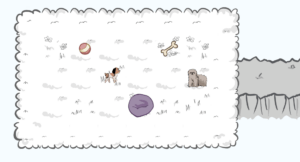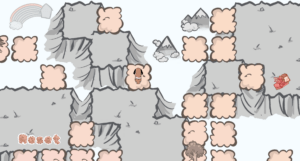I really enjoyed 247G and wish Stanford has more game design courses like it (hopefully there will be in the future)!
Before this class, I had some understanding that to get into game design, I should perform analyses like the type of stuff in Extra Credits and GMTK videos (and some GDC talks about mechanics), and essentially do critical plays and be a game critic. As we see emphasized in this class, this type of framework is certainly accurate to some extent. In this class, critical plays seem primarily intended for everyone to get exposure to a wide variety of genres, which is certainly necessary for a game designer. I have also been aware that it’s important to play a wide variety of games before coming to this class, so none of the genres were new to me, but there are so many angles you can examine a game from in a critical play so they are still very valuable for my reflection.

Pictured: Screenshot from our P2 game, Cloudy Paws. Art by Megan Liu.
I liked the overall theoretical framework presented to examine games. The sections on narrative structure and loops and arcs stuck out to me like the most fundamental to understanding games, and are definitely very useful lenses to examine games through. Perhaps these can be considered as part of low-level game design, and things like puzzle design, chance design, visual design, social design, environment design, and tutorial design are somewhat higher-level game design elements. Things like formal elements, kinds of fun, what are games, and taxonomy of players are also super important low-level elements, but they seem more like considerations before you start making a game, rather than elements you would be directly manipulating in the design of a game. These elements also seem somewhat less concrete—for many types of games, your games will attract killers, achievers, socializers, and explorers, as well as create sense pleasure, fantasy, narrative, challenge, fellowship, competition, discovery, expression, and abnegation in varying ways, so it seems to me while it does make sense to loosely define which of these categories your game is focusing on, inevitably a well-polished (multiplayer) game will appeal to all of these elements in one way or another.
I wish we spent more time with the higher-level elements though. The PvZ talk and the randomness lecture stood out to me as good examples of getting into really nuanced design aspects, but there are so many other aspects that could be interesting to cover (if only we had more than 10 weeks).

Pictured: Another screenshot from our P2 game, Cloudy Paws. Art by Megan Liu.
The actual games we got to create was a fun experience for the most part, I think I learned more about collaboration and grouping on a game in a group rather than anything specifically related to game design or development. I did get to practice the PvZ onboarding guidelines, and it made me rethink our onboarding flow and create very user-friendly and uninsulting hints, which is a very important aspect of game design I previously haven’t given much thought to.
I hope to work on many more games in the future since I love making games, and continue learning game design since it’s so interesting seeing how players interact with your designs!



